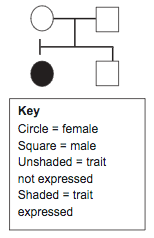What Do You Think ? #2
- Due No Due Date
- Points 10
- Submitting a text entry box
- Attempts 0
- Allowed Attempts 2
Phenotypes
An individual’s phenotype is determined by the traits that are expressed and observed. Suppose that the plant with a genotype of Pp has purple flowers. We say the plant’s phenotype for flower color is purple. The chart below summarizes the possible genotypes and phenotypes resulting from the allele combinations for flower color (purple or white).
Remember, in sexual reproduction, an offspring inherits one allele from each parent.
Allele Combinations for Purple and White Flowers
| Genotype | Phenotype |
| PP | Purple |
| Pp | Purple |
| pp | White |
Dominant and Recessive Alleles
You may have noticed an interesting phenomenon in the chart above. Three different genotypes (PP, Pp, and pp) only produced two phenotypes (purple color or white color). This is because the allele for purple color is dominant, and the allele for white color is recessive. Dominant alleles are expressed if they are present. Recessive alleles are only expressed when the dominant allele is absent. Therefore, PP and Pp genotypes have the same purple phenotype. Only the pp genotype has the white phenotype.
If an organism has two different alleles for a trait, such as Pp, it is heterozygous for that trait. If an organism has the same alleles for a trait (PP or pp), it is homozygous for the trait. PP is classified as homozygous dominant, and pp is classified as homozygous recessive.

Study the diagram above. It represents four people: two parents and their two children. Parents are indicated by the symbols in the top row. Children are indicated by the symbols in the bottom row. Circles represent females and squares represent males.
In this family, only the daughter expresses a particular trait. The other members of the family (unshaded symbols) do not express this trait. Could this trait be dominant, or is it recessive? How do you know?
Rubric
 Find Rubric
Find Rubric
| Criteria | Ratings | Pts |
|---|---|---|
|
This criterion is linked to a Learning Outcome
Description of criterion
threshold:
5 pts
|
This area will be used by the assessor to leave comments related to this criterion.
|
pts
/
5 pts
--
|
|
This criterion is linked to a Learning Outcome
Description of criterion
threshold:
5 pts
|
This area will be used by the assessor to leave comments related to this criterion.
|
pts
/
5 pts
--
|
